Fusion of fastback and notchback
Hidetoshi Aoki
The key designer of Galant Lambda (hereinafter referred to as Lambda) was Ryu Kaibuchi. However, he has already passed away, so I will describe the design development on his behalf, as I was a member of the design team at that time. I am afraid that my memories are incomplete and may not be able to convey the whole picture, since I was an assistant designer then.
―― Nose common or full skin change, fastback or notchback
The development of Lambda started as a variation of Galant Sigma around 1974 when the design development of Sigma was about to be completed. Initially, as was the case with the 1st and 2nd gen. Galant Hardtops, it was assumed that the nose of the base car (Sigma) would be common use. However, discussions were also taking place at the same time on what to do with the successor to the popular Galant GTO, which had been sold across two generations of Galant.
In this situation, various studies were being conducted in the design section, including sketches and 1/1 tape drawing, but for the time being, a proposal to share the nose was made into two clay models ahead of the others. One was a sporty fastback that was intended to be the successor to GTO, and the other was a notchback that emphasized a luxurious image as the successor to Galant Hardtop.

Fastback proposal with shared Sigma nose. Front grille and taillights are rendered

Notch-back proposal with shared Sigma nose
After a while of making the models, I think it was decided that a full skin change proposal also needed to be modeled. There must have been some debate over whether this should be a fastback or a notchback, but naturally, it was decided to go with a fastback model similar to GTO. The model was to use SAE standard four rectangular headlights, which had just been announced in North America, but although the standard was known, no one had ever seen the actual headlights. In the early stages of the model, the front grille was often represented by a 1/1 rendering, and these headlights were rendered as well.

Full skin change proposal
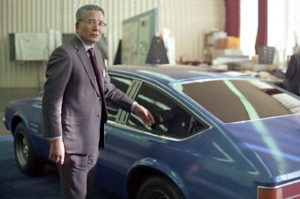
President Kubo checks model
Three proposals were modeled and discussed at a meeting to determine the direction of the project. President Kubo, who had a clear “design-oriented” attitude, was naturally interested in the full skin change proposal. However, at this point, he did not find any of the proposals appealing and said, “We are not there yet,” and did not reach a decision on the direction to take.
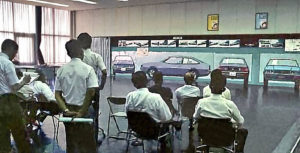
Design review of full-size tape drawings
―― Design that looks both fastback and notchback
Although the direction to proceed with a full skin change has become stronger, the design has not been approved, but has been reworked. Although the president did not seem to be interested in a notchback, the issues of fastback or notchback, shared use or full skin change, continued to smolder. In the midst of all this, Masataka Nimura, then head of the design section, ordered Ryu Kaibuchi to design a car that could look like either a fastback or a notchback. Kaibuchi was a man who showed up at the studio wearing old-fashioned rubber boots on rainy days and a running shirt when it was hot. He was an unconventional figure, far removed from the smartness one might associate with the word “car designer”. However, when it came to car design, he had his unique sensibility and boldness, and could be relied on to show his skills when the time came.

Clay model work on Kaibuchi’s design proposal

Refinement work on original full skin change proposal
He would usually move on to a model as soon as he had made some quick sketches, and he had little interest in making beautiful sketches. Whenever he needed sketches for a presentation, even if I was on another team, he would buy me lunch and ask me to draw them for him. I would then draw the sketches for him. I had done so on several occasions. He was a unique person who acted without regard to the work system, and the design section had a free atmosphere where no one, including his superiors, could blame him for such behavior.
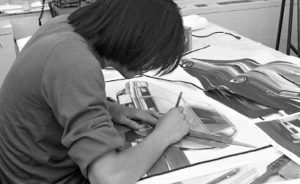
Writer working on rendering sketch
Back to the story. Nimura’s comment was the breakthrough, and Kaibuchi created a semi-fastback silhouette with a roll-bar-like C-pillar that reminded one of a notchback. This full skin change proposal adopted a slanted nose, which had only been seen in the Toyopet Corona and the Cony Guppy in Japan. The headlights were two rectangular lights (later refined to four SAE rectangular lights). The body-colored nose through the center of the grille was a novel and special styling touch.
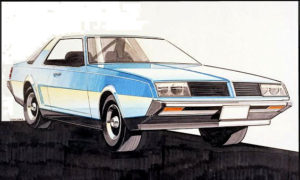
Design proposal with two rectangular headlights
However, other models were also made, including one with a more notchback-style rear window and a slant-forward nose with four round headlights, which was popular at the time, and another with a nose shared with the Sigma, but the decision was ultimately up to the president. The result was the well-known Lambda. Kaibuchi was a key designer of the 2nd gen. Delica and the 2nd gen. Debonair, and also played an important role in various other models, and was recognized by many other members, but I think the Lambda was his best work.
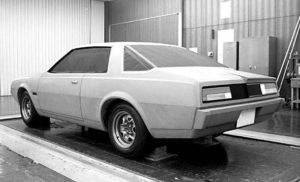
Model with distinctive rear window designed by Kaibuchi
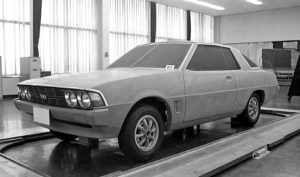
Design proposal with shared nose based on Kaibuchi’s design
―― Managing Director goes to Asahi Glass to negotiate
Needless to say, the ideal rear window should be made of one piece of glass, but initially, it was designed as a three-part structure with blacked-out pillars at the side. This was based on the idea that it would be impossible with the level of technology available at the time. However, perhaps at the special request of President Kubo, Executive Director Mochida brought a picture of the clay model to a close friend at Asahi Glass (now AGC Co., Ltd.) and asked him to make this model a reality.
As a result, that characteristic wraparound rear window became possible. Although a precedent for such a rear window had been made with the Mazda Cosmo Sport, the radius of the folded portion of the Lambda was much smaller, and this was a new technology for domestic models. Although the radius had to be slightly larger than the initial model in the end, we were grateful to Managing Director Mochida’s negotiating skills. Asahi Glass had to make an expensive tool investment, but the Lambda pioneered the use of bent glass designs in domestic cars, which later evolved into sharp-bend glass. Other features of the Lambda included SAE four rectangular lights, a one-spoke steering wheel, and the one-piece aluminum roll bar garnish that was later installed on the Super Touring version, all of which were firsts in Japan. At that time, there seemed to be an overall enterprising spirit, including not only the design section but also the business partners. The designer in charge of roll bar garnish was prepared to split it into three parts, but was surprised to hear that the outsourcing company responded, “No, we’ll do it as one piece.”
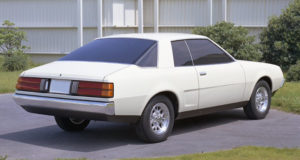
Early design with rear window in three sections
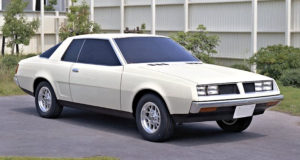
Early design with front center nose
―― Losing center nose
As the design development was nearing the end, the decision to sell the car at both the newly established Car Plaza and existing dealerships, combined with Chrysler’s request, led to making two types of front grille and rear combination lights, respectively. This resulted in the removal of the distinctive body-colored center nose. Although this was a regrettable decision, it was unavoidable due the sales policy.
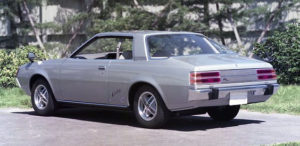
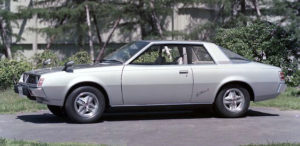
FRP model in final design
―― Magazine scoop
A few months before its release, a magazine published a scoop article with a picture of the Lambda, which I would never forget. It was a black-and-white photo of a model for design review, which was strictly controlled and not supposed to be leaked, and it appeared in a large spread. I still clearly remember that it was a picture of a model with a center nose in the early stages. At the time, there was a lot of speculation in the company, but the truth is still in the dark.
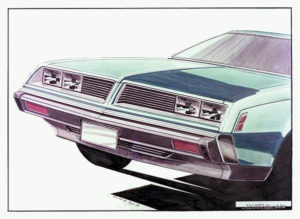
Rendering sketch by Ryu Kaibuchi

Alternative proposal sketch for front by Kaibuchi (left) and writer (right)
―― North American Market
After the Lambda was launched in 1976 as a specialty car to replace Galant GTO, it was extremely popular because of its distinctive design. However, it was in the North American market that it was more successful than in the domestic market, where it greatly increased sales as Chrysler’s Dodge Challenger and Plymouth Sapporo from 1978.

Dodge Challenger for Chrysler Corporation
Back then, Chrysler was amid serious financial difficulties due to the oil crisis. Chrysler, which had focused on large vehicles known as “gas guzzlers,” was able to maintain its operations by selling Mitsubishi models with the low fuel consumption demanded by the market, through a capital tie-up with Mitsubishi that began in 1971. On the other hand, for Mitsubishi, as for other Japanese automakers, the North American market was a true dollar box, and Chrysler was the important partner. Under these circumstances, Challenger and Sapporo must have been easy sellers for Chrysler because their designs appealed to the American public. I believe that the designers played a significant role.
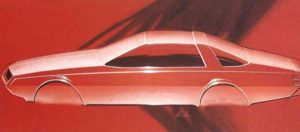
Image sketch for brochure
March 2022
A touch of American interior design
Nobutaka Imada
―― Interior design aims
Lambda was the successor to Galant GTO in Japan and a new two-door specialty car to be sold by Mitsubishi’s partner Chrysler in the US. The product concept for this car was “sporty and high-quality luxury,” and our interior design team began work on the design with these keywords in mind. For the initial design of the instrument panel, a horizontal line featured design ( Proposal A) and a design with a sense of continuity from the instrument panel to the console ( Proposal B) were selected from various sketches drawn by the team, and were modeled. Eventually, my proposal B was selected because of its sportiness and novelty.
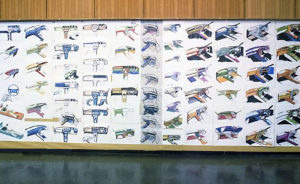
Wall-to-wall idea sketches

Three designs selected from various sketches
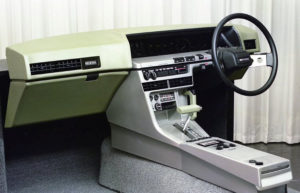
Proposal A featuring horizontal lines
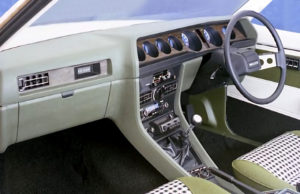
Proposal B featuring continuity from instrument panel to console
―― Instrument panel with “Niagara Falls” image
The instrument panel was designed to resemble “Niagara Falls,” a direct stream of water flowing down from the top center of the instrument panel to the floor console, with the six gauges on the driver’s side, the hallmark of a sports car. The dynamic L-shaped design connecting the gauges to the floor console like a stream of water was intended to create a sporty and specialty interior.
The central part of the console is called the “prime location with high land cost” and is where the components are densely located. In this instrument panel, the console layout became particularly difficult because of the space required for the six gauges, and Saga, in charge of the equipment design engineering, had a very difficult time accommodating the air conditioning control panel, air outlet grille, audio system, ashtray, and other components. Coordination between design and engineering was very contentious, and at one point I was prepared to accept the engineering requirements and change the design. In the end, however, I was grateful that the image of “Niagara Falls” was preserved thanks to Saga’s efforts. The steering wheel was the first in Japan to feature a single spoke, and in combination with this instrument panel, it created a special atmosphere.

Layout study with tape drawing
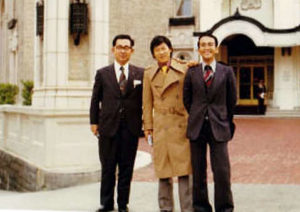
Ishida, general manager of product development dept. (left) Writer (center) Mitsuo Kamaike (right)
―― To the U.S., automobile powerhouse
Since Chrysler accounted for a large portion of the Lambda’s sales, President Kubo ordered us to get the opinion of Richard Macadam, vice president of Chrysler, on the design of the Lambda’s instrument panel. In October 1975, Mitsuo Kamaike, our team leader, Michio Ishida, the head of the Product development department, and I headed to the U.S.
The purpose of the trip was to collaborate with the Chrysler designers to refine the instrument panel design. It was already a harsh winter in Detroit. The cars were running on icy roads, we almost got lost in the huge parking lot of a shopping center, and I couldn’t help but pull up the collar of my coat in the cold and the anxiety. In my first American city, I repeatedly felt uncontrollable excitement every time I saw typical American sports cars, such as Mustang, Corvette, Camaro, or Challenger. On the other hand, when I saw the reality of dubious vehicles mixed in, such as rusty bumper-dragging old cars and pickup trucks with sheds on them, I could only marvel at the difference between the Japanese and American car societies. Now back to the main topic at hand.
―― Working with Chrysler
It was a new experience for us to collaborate on sketches and tape drawings in Chrysler studio. Harold Pilkey of the International Group and two of his staff members were in charge of the project under Bill Brownlie, the head of the styling department. Pilkey was a very friendly person who often cracked jokes, and he made the meeting cheerful and enjoyable, while at the same time being open to our opinions. At a joint meeting held on the last day, the proposed improvements were approved by Vice President MacAdam, who also made the following comments. “The Americans’ lives revolve around their cars, and they spend a lot of time in them. Therefore, they prefer a relaxing and open interior.” He also said, “We would like you to make an effort to reduce the protruding portion of the instrument panel as much as possible.” Although we had to reconsider the amount of protrusion in response to his request, I was relieved that Chrysler’s approval had been obtained.
On my first return to Japan, we reported our joint work to President Kubo, and both companies gave their approval for the design. When we returned to Okazaki, Saga told me the results of his study, “We may be able to reduce the protrusion of the instrument panel by 10 mm.”

Bill Brownlie (left) giving a presentation at design studio in Okazaki, Japan
―― Collaboration with ” Craftsmanship” for production
Upon considering the production of the instrument panel, it was decided that the surface would be finished in a cowhide style to create a high-quality image. At the time, the “slush mold” method, which was developed to give the appearance of leather upholstery, was beginning to be used in some high-end luxury cars, and after considering its profitability and other factors, the decision was made to use this method, knowing that it would increase costs somewhat. Mitsuboshi Belting Ltd., a Komaki-based company specializing in this technology, was selected as the supplier.
From this point on, ” Craftsmanship” came into play. At the time, I had almost no knowledge of leather, so I had to rely on a master craftsman at Mitsubishi Belting to do all the work from material selection to the completion of the master model. Iseki was in charge of this work, and his expertise was so highly valued that he continued to work on his work even after he reached retirement age. Iseki had worked on similar instrument panels in the past, so it was easy for me to share the same image. First, he selected a material he liked from many samples of cowhide. Then, on the surface of the master model covered with cowhide, he stitched a thread through each hole as if he was actually sewing with a sewing machine. This is a tremendous process that requires skill and time. Without stopping his work, Iseki spoke enthusiastically about leather materials, processing methods, and his background. If there was a part that he did not like, he would place wax on it and carve it, a process that required patience and perseverance. The completed master model was so detailed and wonderful that I was impressed by the excellence of human handwork. After that, vinyl chloride was poured into a mold inverted from the master model to create the skin of the pad, and urethane was injected into the inside of the skin to complete the instrument panel pad. Furthermore, as with the instrument panel, the steering wheel and other parts operated by a driver were coordinated with soft leather upholstery. The resulting interior, centered around the sporty cockpit, had a sense of high quality luxury that complemented Lambda’s image.
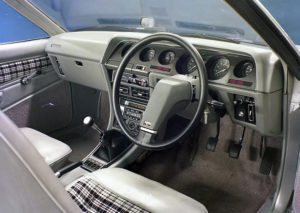
―― Thorough color coordination
Although I was not in charge of color and trim, the Lambda was unique in terms of the color scheme, so let me mention something about it here. The color and trim staffs of Mitsubishi and Chrysler had been in contact with each other for a long time, and for Mitsubishi, information on colors in the U.S., a large market, was valuable. Historically, American cars have been characterized by coordinating body and interior colors, and this was a major difference between American and Japanese cars. Since sales at Chrysler were important for the Lambda, color coordination tailored to their needs was implemented for the domestic market as well. Three interior colors (gray, beige, and red) were combined with five body colors. In addition, the instrument panel, steering wheel, door trim, seats, seatbelts, carpets, and ceiling linings were color-coordinated with the interior color. This was very fresh and fashionable in Japan.
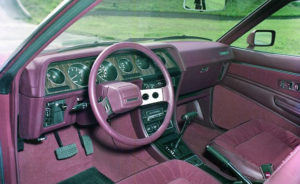
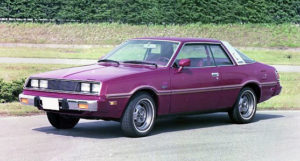
Plymouth Sapporo
―― In closing
At a time when Japan was in an economic boom, Mitsubishi was able to enhance its corporate image by launching the Lambda with the slogan “sporty and luxurious”. While the product planning was good, I feel that the design, both exterior and interior, did a good job of expressing the “sporty and luxurious”, with an eye toward the United States. Even today, there are many fans of the Lambda, who say, “I still wish I had one if I could get a new one,” “Mitsubishi cars from the good old days were the best,” “Stylish and fashionable!” and “American styling and the one-spoke steering wheel were stylish,” etc. It is a pleasure to hear such praise. For me, the collaboration with Chrysler in the U.S. and the encounters with the master craftsman through this project were very valuable experiences, and I believe that I had a meaningful and enjoyable time. In addition, I am nostalgic and grateful for the many friends I have met through this project.
November 2021
One-spoke steering wheel
Haruhisa Ohtsubo
The 1st gen. Lambda steering wheel was predicated on the use of a single spoke even before I began work on the design. This was because Kubo, who became president in 1973, declared that he would proactively incorporate new technology in new models from that point on, and the one-spoke design was planned from the early stage. I thought this was something very new and interesting, and proceeded with the design. The one-spoke design, which began with Citroën DS, which was called a “spaceship,” was well integrated with its avant-garde exterior design. In contrast, Lambda was a stylish sporty coupe with an American taste, and if the image of Citroën DS is retained, the steering wheel alone may look out of place in the overall interior. The biggest challenge was how to integrate it into Lambda’s instrument panel.
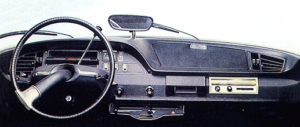
Steering wheel of Citroen DS
The column cover for the steering wheel was to be the same as that of Galant Sigma, with a hexagonal cross section. The first step was to create a continuous shape with the column cover extending as it is. However, I did not want it to look as if it simply drooped forward. Therefore, I made a number of minor modifications to achieve a simple and sharp form, and as a result, I was able to harmonize it well with the design image of the instrument panel. In addition, I added a silver plate as an accent at the joint with the grip to create a stylish and tight impression. The single spoke is structurally prone to lack of strength, but after repeated strength tests conducted by the vendor, Izumi Motors, the problem was solved by adding reinforcement to the core.

The advantage of the one-spoke design is its high visibility, which makes it very easy to check the gauges and levers on the column. For my sake, therefore, I wanted the design of the levers to match the steering wheel, instead of common to Sigma, but I had to give up on that due to the component parts commonization policy. In recent years, the design of the grip section equipped with a knob to stabilize both hands has become more common, but I regret that I did not come up with such idea at the time.
Although I have some regrets, I am very satisfied that we took on the challenge of designing the first one-spoke steering wheel in Japan and were able to realize it. And even now, I am pleased when Mitsubishi car fans tell me, “The interior of the 1st gen. Lambda was very distinctive because of its one-spoke steering wheel.
November 2021